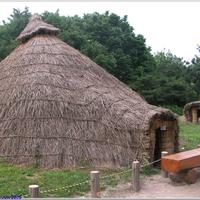VISIT SEOUL-서울기행5 암사동선사주거지(Prehistoric site)
visit|Seoul|Seoul Tour|Amsa-dong prehistoric site||
VISIT SEOUL-Seoul Travel 5 Amsadong Seonsa Residence (Prehistoric site)
VISITER SEOUL - Seoul Travel 5 Amsadong Seonsa Residence (Prehistoric site)
VISIT SEOUL-ソウル紀行5 암사동 선사유적지(Prehistoric site)
Visit SEOUL - Seoul Travel 5 Rezydencja Amsadong Seonsa (miejsce prehistoryczne)
ВИЗИТ СЕУЛ - Сеул Путешествие 5 Резиденция Амсадонг Сонса (доисторическое место)
參觀首爾-首爾旅遊 5 巖寺洞史前遺址
석기시대 사람들은 어떻게 생긴 집에서 무엇을 먹고 살았을까요?
Stone Age|||||||lived
What did people in the Stone Age eat and live in a house that looked like this?
학교에서 배우긴 하지만 구체적으로 설명하라면 더듬거리기 일쑤입니다.
at school|I learn|but|specifically||stammering|tend
Although I learn it in school, I often stutter when I need to explain it in detail.
그런 문제를 단번에 풀어주는 곳이 서울에 있습니다.
||at once|solving|||
There's a place in Seoul that solves that problem once and for all.
바로 강동구 암사동에 있는 암사선사주거지인데요, 이곳에 가면 6000년 전 선사인들이 살던 모습을 한 눈에 볼 수 있습니다.
|||||||||prehistoric people|||||||
This is Amsa Seonsa Residence in Amsa-dong, Gangdong-gu, where you can see how the seons lived 6000 years ago.
[…]
들어가는 입구 한쪽에는 신석기인들이 만들어 썼던 토기 모형도 보입니다.
|||Neolithic people|||pottery|model|
To one side of the entrance, you'll also see a model of a Neolithic pottery.
가장 눈길을 끄는 것은 옛 모양을 복원해 놓은 움집들입니다.
|attention|attracting||||restoring|restored|dugouts
The most eye-catching are the huts that have been restored to their former appearance.
이 암사선사유적지가 발견된 것은 1925년 대홍수 때입니다.
||was discovered|||great flood|
The site was discovered during the Great Flood of 1925.
한강이 넘치면서 유적 일부가 발견된 이후 1967년에 첫 발굴 조사를 했습니다.
|overflowing|ruins|some|||||excavation|excavation|
The first excavations were carried out in 1967 after the Han River overflowed and uncovered some of the ruins.
1971∼1975년에 재발굴 조사한 뒤 1984년과 1998년에 다시 발굴했습니다.
|re-excavation||||||excavated
It was excavated in 1971-1975 and then again in 1984 and 1998.
그 결과 수렵·채집으로 생활하며 취락을 형성한 것으로 추정되는 집터와 빗살무늬토기를 비롯해 돌도끼·돌화살 그리고 돌낫·보습과 같은 석기가 대량 출토됐습니다.
||hunting|gathering||settlements|established||is presumed|house site|cord-marked pottery|including|stone axe|stone arrowhead||stone sickle|sickle||stone tools||were excavated
The excavations resulted in the discovery of house sites and combed earthenware, as well as stone tools such as stone axes, stone arrows, and stone flakes, which are believed to have been used by hunter-gatherers.
움집터에는 복원움집들과 함께 직접 들어가 볼 수 있는 체험움집이 있습니다.
the thatched house site|restored traditional houses||directly|to enter||||experience house|
집터는 지금까지 약 30여기가 발굴됐는데 이 자리에 9채를 복원했습니다.
house site|||houses|have been excavated||site|houses|
실제보다 약 1.5배로 확대해서 지었다는 체험움집으로 들어가 보겠습니다.
actual|||enlarged|that was built|experience house||
입구가 무척 낮아서 허리를 구부려야 들어갈 수 있습니다.
|very||||||
집은 대부분 70cm에서 1m 정도 땅을 판 뒤 원형이나 네모꼴로 지었습니다.
||||||||circular|square|I built
네 모서리에 기둥을 세우고 기둥들을 통나무로 연결한 뒤 갈대나 억새로 지붕을 덮었습니다.
|corners|posts||posts|logs|||reeds|reed|roof|I covered
안으로 들어오니 생각보다 아늑합니다.
inside|||cozy
짐승가죽으로 만든 옷을 입고 있는 네 명의 가족이 있습니다.
animal skin||||||||
가장은 내일 있을 수렵을 준비하는지 창을 손질하고 나머지 가족들은 가운데에 있는 화덕에 불을 피우거나 음식을 만들고 있습니다.
|||hunting|||sharpening|||||fireplace||lighting|||
천장에는 환기구를 만들어 연기가 빠져나가도록 해두었고 연기가 닿는 곳에는 물고기를 매달아서 장기간 보존할 수 있도록 했습니다.
the ceiling|ventilation duct|I made|smoke|to escape|I had set up|||||||preserve|||
한쪽에는 빗살무늬토기에 곡식을 담아 놓았고, 고기를 잡을 때 쓰는 그물도 걸어 놓았습니다.
|comb-patterned pottery|grains|||||||net||
움집에서 나오면 전시관이 있습니다.
the hut||exhibition hall|
제1전시관, 제2전시관으로 나눠져 있는데요.
|||exhibition hall|is divided into|
제1전시관에는 움집터 발굴현장의 모형을 재현해 놓아서, 발굴 당시 현장감을 느낄 수 있습니다.
||dwelling site|excavation site|model|reproduced||||atmosphere|||
주변에는 신석기인들이 썼던 불 피우는 도구와 사냥 때 쓰는 돌도끼와 활, 돌화살, 물고기를 잡을 때 쓰는 낚시 바늘, 그리고 빗살무늬토기 등이 전시돼 있습니다.
the surroundings|||||tools|hunting|||||||catch|||fishing|fishing hook||cord-marked pottery|||
또 당시의 생활상을 쉽게 이해할 수 있도록 벽에 그림을 그려놓았습니다.
|||||||||I drew
제2전시관에는 구석기시대의 생활, 신석기인의 농경생활, 암사인의 생활상 등과 함께 우리나라 지역별 신석기 문화, 초기 청동기문화 등을 소개하고 있습니다.
||||Neolithic|agricultural life|Amisan|||||regional|Neolithic||early|early Bronze Age culture||introducing|
The second exhibition hall introduces the lifestyle of the Paleolithic era, the agricultural life of Neolithic people, and the way of life of the Amsha people, along with the regional Neolithic culture and early Bronze Age culture of our country.
이밖에도 움집 복원모형과 주거지 발굴 당시 상황을 재현해 놓은 모형이 전시돼 있습니다.
In addition, models of restored pit houses and a model that recreates the situation during the excavation of residential sites are on display.
전시관을 나와 나무다리를 건너면 시간의 길을 지나게 됩니다.
||wooden bridge|||||
When you exit the exhibition hall and cross the wooden bridge, you will pass through the path of time.
이 길은 긴 동굴 형태로 돼 있는데 현대의 발달된 모습과 1900년대의 모습, 그리고 조선시대‧고려시대‧신라시대‧선사시대를 상징하는 대표적인 그림이나 사진을 모니터를 통해 차례로 볼 수 있습니다.
|||cave|shape||||developed||||||||prehistory|symbolizing|||||||||
천천히 걸어가다 보면 타임머신을 타고 시간여행을 하는 느낌이 듭니다.
시간의 길을 빠져나오면 선사시대의 모습을 재현해 놓은 선사체험마당과 만납니다.
||you exit|prehistoric|||||
선사체험마당은 체험학습 마당입니다.
아이들이 배우고 즐길 수 있는 곳인데요.
수렵, 움집만들기 체험은 물론 7~9월에 진행되는 채집, 어로체험에 직접 참여할 수 있습니다.
|building a pit house||||taking place||fishing||||
이밖에도 불 피우기, 사냥도구 만들기, 빗살무늬토기 만들기 등 다양한 체험 프로그램이 진행됩니다.
||fire-making|hunting tools|||making|||experiential||
매일 책으로만 보았던 유물들을 직접 보고 만들어볼 수 있기 때문에 아이들이 무척 좋아할 것 같습니다.
|books||artifacts|||to create||||||will like||
이곳 선사주거지는 유물들을 보고 체험하는 것은 물론 곳곳에 작은 공원들이 있어서 지친 도시인들의 휴식공간으로도 각광을 받고 있습니다.
|||||||||||weary|city dwellers|a place to rest|popularity||
조금만 들어가면 나무들이 늦가을 빛으로 곱게 치장한 풍경이 펼쳐지고 곳곳에 쉼터도 마련돼 있습니다.
|||late autumn|autumn light||adorned||unfolds||rest areas|is provided|
기분 전환도 하고 선사인들의 삶도 느껴볼 수 있는 암사동 선사유적지, 휴일에 가족과 함께 찾아가보는 건 어떨까요.
mood|change|||lives|||||||||||
서울신문 이호준입니다.
글 / 이호준선임기자 sagang@seoul.co.kr
영상 / 장고봉PD goboy@seoul.co.kr

